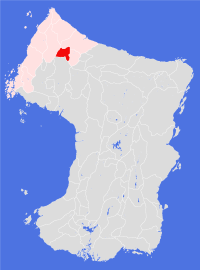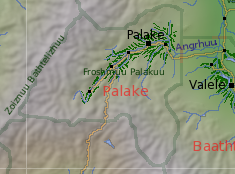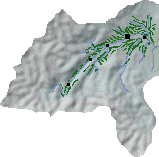Palake

Societal ties: Bartak
Current population: 1
Main language(s): Varam Bathtel
Area: 77,000km²
Natural and political borders
The Froshmuu Palakuu penetrates deep into the Zoiznuu Bathtelizhuu, which surrounds the valley from the north, west and south.
As part of the New Agreement, the Froshmuu Palakuu consists of all the valleys drained by the Angrhuu river west of longitude 163.5°E.
History
Alongside Valele and Tentole Plantations, Palake Plantation was part of the second stage of the planned expansion to accommodate refugees from the Tells region in Cheidrah. The decision to locate a settlement at such an altitude was made easier by the discovery of a Type Two life ark (oasis) in gt542, in one of the tributaries of the upper reaches of the river. Soil brewers were able to replicate the soil ecosystem fairly quickly and make use of some of the novel plants found surviving in the ark - in particular soft fruits such as plums, blueberries, blackberries and strawberries. The ark was also home to colonies of honey bees, mice and small cats - settlers adopted the small cat, which scientists believe is a different species to the domestic cat, as the city emblem in the gt570s.
From the start, settlement numbers in the valley had to be controlled; the valley climate resembled that of the Tells region in a number of ways, making it an extremely popular destination of choice. Rationing of places in the settlement was supposed to be on merit, but petty corruption soon made its mark and permits to settle tended to go to those who could pay for them. Without a permit to settle or trade, people were not allowed to enter the valley - the plantation was the first in the Bartak Lands to employ armed security and set up a patrolled border.
Nevertheless, the plantation grew quite quickly, with four additional settlements being established in the valley by the gt670s. Much of the plantation's cultivation was devoted to luxury goods such as the soft fruits, and to pasture land which could support horses and cattle. These were traded for basic food commodities with the settlements downstream, principally the city of Defe.
The role of the city of Palake changed in gt720 when the new Bartekol League chose to establish its administrative centre in the city. Diplomacy bought new wealth to the city, and an explosion in services to support the League administration. However, the influx of diplomats and their entourages were not particularly welcomed by the local population, who saw their influence on local politics diminished by the needs of the new arrivals.
The first League administrations were both inept and corrupt. In gt751 a rival administration was set up by the League members in Defe, and conflict between the two administrations became a distinct possibility. The city authorities chose to support the old regime, though its support did not extend much beyond the city's council chamber. As the political crisis deepened people associated with the old administration began asset-stripping the city. When riots by the locals against the old administration broke out in neighbouring settlements and spread to the poorer neighbourhoods of Palake the administration panicked, ordering the city guard to fire on the rioters. The city guard, recruited locally, mutinied; within days the crisis was over and people associated with the authority were fleeing the city. A few of the key figures were captured and handed over to the new authority in Defe; others were quietly murdered, but most managed to escape back to their home lands.
Because of the need for secrecy, Palake had not been included - or informed - of the moves to oust the old League authority, and thus was not a founder member of the New Bartekol Agreement. Negotiations to join the new League began within days of the collapse of the old authority: Palake became the 10th Bartak Land within the League in gt752. However, the new authority did not return to the city for another three orbits, mainly because the city was not keen to host the diplomats. Only once the city and the new authority had agreed a strict protocol limiting the authority's influence over local politics and the local economy did the city relent.
Between the League's rebirth in gt751 and its demise in gt1033 the city and the administration managed to develop and maintain a civil cohabitation. Over time, the city adapted to the needs of the authority, but also developed a range of alternative industries. Thus as the influence of the League diminished in the tenth and eleventh centuries the city and the Land were able to adapt without serious repercussions for the local economy.

Politics and economy
The city has always been the focus of the Land's politics and economy - the four settlements are considered to be detached suburbs - known as holdings - of the city and elected representatives from the settlements sit on the city council. In effect, Palake is a city state, with a strong tradition of representative democracy.
Trade is central to the Land's economic health; the production of luxury goods and services - especially agricultural goods - remains the mainstay of the economy. Despite its mountainous environment, there are no mining settlements in the Land, apart from local stone quarries and aggregate mines.
Perhaps surprisingly, the Land does not have its own currency; instead the Varhamyuuse Tal is the local currency of choice.
Culture and other issues of interest
Religion has always played an important part in the life of the average Palakian, and temples - and creeds - are numerous. However, while the temples are the cultural bedrock of the holdings (neighbourhoods), they do not play much of a role in either local or city politics, and there is a separate, independent judicial system.
Palake is the only Bartak Land to operate a form of national service. All young people are expected to serve for two orbits in the city guard, though nowadays this duty is combined with further education, voluntary work with the temples, or work on maintaining and developing the extensive terraces that make up the Land's cultivated area.
The Land remains rich, with the highest per-capita income of any Bartak Land. Some people believe that shopping is the true religion in Palake.
Key natural features
Palake is the highest Land of the Bartak Lands, with the highest city and the highest permanently inhabited settlement. Mt Koletein (5,640m) on the north west border is the highest point in the Land; other mountains include Mt Zamalein (5,030m) in the west and Mt Palakuu (4,270m) in the south east.

Habitats
The eastern and southern parts of the Land consist of northern mountain habitat; northern scrubland predominates over much of the rest of the valley.
Plantations and settlements
Palake Plantation stretches some 140km along the upper reaches of the Angrhuu river, supporting three settlements in addition to the city itself. The plantation has been extensively terraced. A fourth settlement lies 100km upriver of the city.
The original life ark still exists, in the upper reaches of the northern tributary which joins the Angrhuu within the city limits.
Key towns and cities
Rural population: 0 (0.0% of total)